Pilot Study on High-Intensity Focused Ultrasound (HIFU) for Basal Cell Carcinoma: Effectiveness and Safety
Abstract
1. Introduction
2. Materials and Methods
2.1. Study Population and Lesion Selection
2.2. Dermoscopic Evaluation
2.3. High-Intensity Focused Ultrasound (HIFU) Treatment
2.4. Post-Treatment Observations
2.5. Ethical Compliance
3. Results
3.1. Clinical and Dermoscopic Involution of HIFU-Treated Basal Cell Carcinoma
3.2. Adverse Event Incidence Post-HIFU Treatment: Symptomatology and Frequency Analysis
3.3. Quantitative Evaluation of Post-HIFU Treatment Patient Responses: A Longitudinal Assessment
3.3.1. Immediate Post-HIFU Treatment Observations
3.3.2. Two Weeks following HIFU Treatment
3.3.3. Three Months Post-HIFU Procedure
3.3.4. Six Months after HIFU Treatment
4. Discussion
5. Conclusions
Author Contributions
Funding
Institutional Review Board Statement
Informed Consent Statement
Data Availability Statement
Conflicts of Interest
References
- Al-Qarqaz, F.; Marji, M.; Bodoor, K.; Almomani, R.; Al Gargaz, W.; Alshiyab, D.; Muhaidat, J.; Alqudah, M. Clinical and Demographic Features of Basal Cell Carcinoma in North Jordan. J. Ski. Cancer 2018, 2018, 2624054. [Google Scholar] [CrossRef]
- Fijałkowska, M.; Bonczar, M.; Jastrzębski, I.; Ostrowski, P.; Antoszewski, B.; Koziej, M. Growth rate of basal cell carcinoma: A meta-analysis and systematic review. Adv. Dermatol. Allergol. Dermatologii Alergol. 2023, 40, 220–224. [Google Scholar] [CrossRef] [PubMed]
- Wu, S.; Han, J.; Li, W.-Q.; Li, T.; Qureshi, A.A. Basal-Cell Carcinoma Incidence and Associated Risk Factors in US Women and Men. Am. J. Epidemiol. 2013, 178, 890. [Google Scholar] [CrossRef] [PubMed]
- Reinau, D.; Surber, C.; Jick, S.S.; Meier, C.R. Epidemiology of basal cell carcinoma in the United Kingdom: Incidence, lifestyle factors, and comorbidities. Br. J. Cancer 2014, 111, 203. [Google Scholar] [CrossRef]
- Verkouteren, J.; Ramdas, K.; Wakkee, M.; Nijsten, T. Epidemiology of basal cell carcinoma: Scholarly review. Br. J. Dermatol. 2017, 177, 359–372. [Google Scholar] [CrossRef]
- Harken, E.B.O.; Fazio, J. Basal Cell Carcinoma. In Atlas of Dermatologic Diseases in Solid Organ Transplant Recipients; Springer: Cham, Switzerland, 2022; pp. 331–346. [Google Scholar] [CrossRef]
- Quazi, S.J.; Aslam, N.; Saleem, H.; Rahman, J.; Khan, S. Surgical Margin of Excision in Basal Cell Carcinoma: A Systematic Review of Literature. Cureus 2020, 12, e9211. [Google Scholar] [CrossRef]
- Paoli, J.; Gyllencreutz, J.D.; Fougelberg, J.; Backman, E.J.; Modin, M.; Polesie, S.; Zaar, O. Nonsurgical Options for the Treatment of Basal Cell Carcinoma. Dermatol. Pract. Concept. 2019, 9, 75. [Google Scholar] [CrossRef]
- Trakatelli, M.; Morton, C.; Nagore, E.; Ulrich, C.; Del Marmol, V.; Peris, K.; Basset-Seguin, N. Update of the European guidelines for basal cell carcinoma management. Eur. J. Dermatol. 2014, 24, 312–329. [Google Scholar] [CrossRef] [PubMed]
- Kim, J.Y.S.; Kozlow, J.H.; Mittal, B.; Moyer, J.; Olencki, T.; Rodgers, P.; Bichakjian, C.; Armstrong, A.; Baum, C.; Bordeaux, J.S.; et al. Guidelines of care for the management of basal cell carcinoma. J. Am. Acad. Dermatol. 2018, 78, 540–559. [Google Scholar] [CrossRef]
- Naik, M.P.; Mehta, A.; Abrol, S.; Kumar, S.; Gupta, V.S. Topical 5% 5-fluorouracil in the treatment of multifocal basal cell carcinoma of the face: A novel chemotherapeutic approach. Orbit 2016, 35, 352–354. [Google Scholar] [CrossRef]
- Oldfield, V.; Keating, G.M.; Perry, C.M. Imiquimod: In superficial basal cell carcinoma. Am. J. Clin. Dermatol. 2005, 6, 195–200. [Google Scholar] [CrossRef] [PubMed]
- Neumann, K.; Bettencourt, M.S. Treatment of superficial basal cell carcinoma with ingenol mebutate gel, 0.05%. Clin. Cosmet. Investig. Dermatol. 2016, 9, 205. [Google Scholar] [CrossRef]
- Gambini, D.; Passoni, E.; Nazzaro, G.; Beltramini, G.; Tomasello, G.; Ghidini, M.; Kuhn, E.; Garrone, O. Basal Cell Carcinoma and Hedgehog Pathway Inhibitors: Focus on Immune Response. Front. Med. 2022, 9, 893063. [Google Scholar] [CrossRef] [PubMed]
- Cho, M.; Gordon, L.; Rembielak, A.; Woo, T. Utility of radiotherapy for treatment of basal cell carcinoma: A review. Br. J. Dermatol. 2014, 171, 968–973. [Google Scholar] [CrossRef] [PubMed]
- Lear, J.T.; Corner, C.; Dziewulski, P.; Fife, K.; Ross, G.L.; Varma, S.; Harwood, C.A. Challenges and new horizons in the management of advanced basal cell carcinoma: A UK perspective. Br. J. Cancer 2014, 111, 1476–1481. [Google Scholar] [CrossRef] [PubMed]
- Copelan, A.; Hartman, J.; Chehab, M.; Venkatesan, A.M. High-Intensity Focused Ultrasound: Current Status for Image-Guided Therapy. Semin. Interv. Radiol. 2015, 32, 398. [Google Scholar] [CrossRef] [PubMed]
- Bove, T.; Zawada, T.; Serup, J.; Jessen, A.; Poli, M. High-frequency (20-MHz) high-intensity focused ultrasound (HIFU) system for dermal intervention: Preclinical evaluation in skin equivalents. Ski. Res. Technol. 2019, 25, 217–228. [Google Scholar] [CrossRef] [PubMed]
- Serup, J.; Bove, T.; Zawada, T.; Jessen, A.; Poli, M. High-frequency (20 MHz) high-intensity focused ultrasound: New Treatment of actinic keratosis, basal cell carcinoma, and Kaposi sarcoma. An open-label exploratory study. Ski. Res. Technol. 2020, 26, 824–831. [Google Scholar] [CrossRef] [PubMed]
- Calik, J.; Migdal, M.; Zawada, T.; Bove, T. Treatment of Seborrheic Keratosis by High Frequency Focused Ultrasound—An Early Experience with 11 Consecutive Cases. Clin. Cosmet. Investig. Dermatol. 2022, 15, 145–156. [Google Scholar] [CrossRef]
- Zawada, T.; Bove, T. Strongly focused hifu transducers with simultaneous optical observation for treatment of skin at 20 MHZ. Ultrasound Med. Biol. 2022, 48, 1309–1327. [Google Scholar] [CrossRef]
- Bove, T.; Zawada, T.; Jessen, A.; Poli, M.; Serup, J. Removal of Common Warts by High-Intensity Focused Ultrasound: An Introductory Observation. Case Rep. Dermatol. 2021, 13, 340–346. [Google Scholar] [CrossRef] [PubMed]
- Calik, J.; Zawada, T.; Bove, T. Treatment of superficial benign vascular tumors by high intensity focused ultrasound: Observations in two illustrative cases. J. Cosmet. Dermatol. 2022, 21, 3371–3379. [Google Scholar] [CrossRef] [PubMed]
- Smoczok, M.; Leonik, S.; Bergler-Czop, B. High-intensity focused ultrasound technology as a non-surgical alternative to face lifting. Dermatol. Rev. Dermatol. 2022, 109, 130–137. [Google Scholar] [CrossRef]
- Peris, K.; Fargnoli, M.C.; Kaufmann, R.; Arenberger, P.; Bastholt, L.; Seguin, N.B.; Bataille, V.; Brochez, L.; del Marmol, V.; Dummer, R.; et al. European consensus-based interdisciplinary guideline for diagnosis and treatment of basal cell carcinoma—Update 2023. Eur. J. Cancer 2023, 192, 113254. [Google Scholar] [CrossRef] [PubMed]
- Badash, I.; Shauly, O.; Lui, C.G.; Gould, D.J.; Patel, K.M. Nonmelanoma Facial Skin Cancer: A Review of Diagnostic Strategies, Surgical Treatment, and Reconstructive Techniques. Clin. Med. Insights Ear Nose Throat 2019, 12, 117955061986527. [Google Scholar] [CrossRef] [PubMed]
- Wollina, U.; Bennewitz, A.; Langner, D. Basal cell carcinoma of the outer nose: Overview on surgical techniques and analysis of 312 patients. J. Cutan. Aesthetic Surg. 2014, 7, 143. [Google Scholar] [CrossRef] [PubMed]
- Rogalski, C.; Kauer, F.; Simon, J.C.; Paasch, U. Meta-analysis of published data on incompletely excised basal cell carcinomas of the ear and nose with introduction of an innovative treatment strategy. JDDG J. Dtsch. Dermatol. Ges. 2007, 5, 118–126. [Google Scholar] [CrossRef] [PubMed]
- Smith, V.; Walton, S. Treatment of Facial Basal Cell Carcinoma: A Review. J. Ski. Cancer 2011, 2011, 380371. [Google Scholar] [CrossRef] [PubMed]
- Li, H.; Yuan, S.-M.; Yang, M.; Zha, H.; Li, X.-R.; Sun, H.; Duan, L.; Gu, Y.; Li, A.-F.; Weng, Y.-G.; et al. High intensity focused ultrasound inhibits melanoma cell migration and metastasis through attenuating microRNA-21-mediated PTEN suppression. Oncotarget 2016, 7, 50450. [Google Scholar] [CrossRef]
- Lucena, S.R.; Salazar, N.; Gracia-Cazaña, T.; Zamarrón, A.; González, S.; Juarranz, Á.; Gilaberte, Y. Combined Treatments with Photodynamic Therapy for Non-Melanoma Skin Cancer. Int. J. Mol. Sci. 2015, 16, 25912–25933. [Google Scholar] [CrossRef]
- Kaw, U.; Ilyas, M.; Bullock, T.; Rittwage, L.; Riha, M.; Vidimos, A.; Hu, B.; Warren, C.B.; Maytin, E.V. A regimen to minimize pain during blue light photodynamic therapy of actinic keratoses: Bilaterally controlled, randomized trial of simultaneous versus conventional illumination. J. Am. Acad. Dermatol. 2020, 82, 862. [Google Scholar] [CrossRef] [PubMed]
- Ang, J.M.; Bin Riaz, I.; Kamal, M.U.; Paragh, G.; Zeitouni, N.C. Photodynamic therapy and pain: A systematic review. Photodiagnosis Photodyn. Ther. 2017, 19, 308–344. [Google Scholar] [CrossRef] [PubMed]
- Warren, C.B.; Karai, L.J.; Vidimos, A.; Maytin, E.V. Pain associated with aminolevulinic acid-photodynamic therapy of skin disease. J. Am. Acad. Dermatol. 2009, 61, 1033–1043. [Google Scholar] [CrossRef] [PubMed]
- Ceilley, R.I.; Del Rosso, J.Q. Current modalities and new advances in the treatment of basal cell carcinoma. Int. J. Dermatol. 2006, 45, 489–498. [Google Scholar] [CrossRef] [PubMed]
- Siemionow, M.; Gatherwright, J.; Djohan, R.; Papay, F. Cost analysis of conventional facial reconstruction procedures followed by face transplantation. Am. J. Transplant. 2011, 11, 379–385. [Google Scholar] [CrossRef] [PubMed]
- Niculet, E.; Bobeica, C.; Onisor, C.; Gurau, G.; Nechita, A.; Radaschin, D.S.; Tutunaru, D.; Bujoreanu-Bezman, L.; Tatu, A.L. Basal Cell Carcinoma Perineural Invasion and Suggestive Signs of Perineural Invasion—Findings and Perspectives. Life 2023, 13, 1406. [Google Scholar] [CrossRef]
- Hill, M.J.; Hoegler, K.M.; Zhou, A.E.; Snow, C.R.; Khachemoune, A. A systematic review of the incidence of basal cell carcinoma with perineural invasion: Conventional pathology versus Mohs micrographic surgery. Arch. Dermatol. Res. 2023, 315, 127–132. [Google Scholar] [CrossRef]

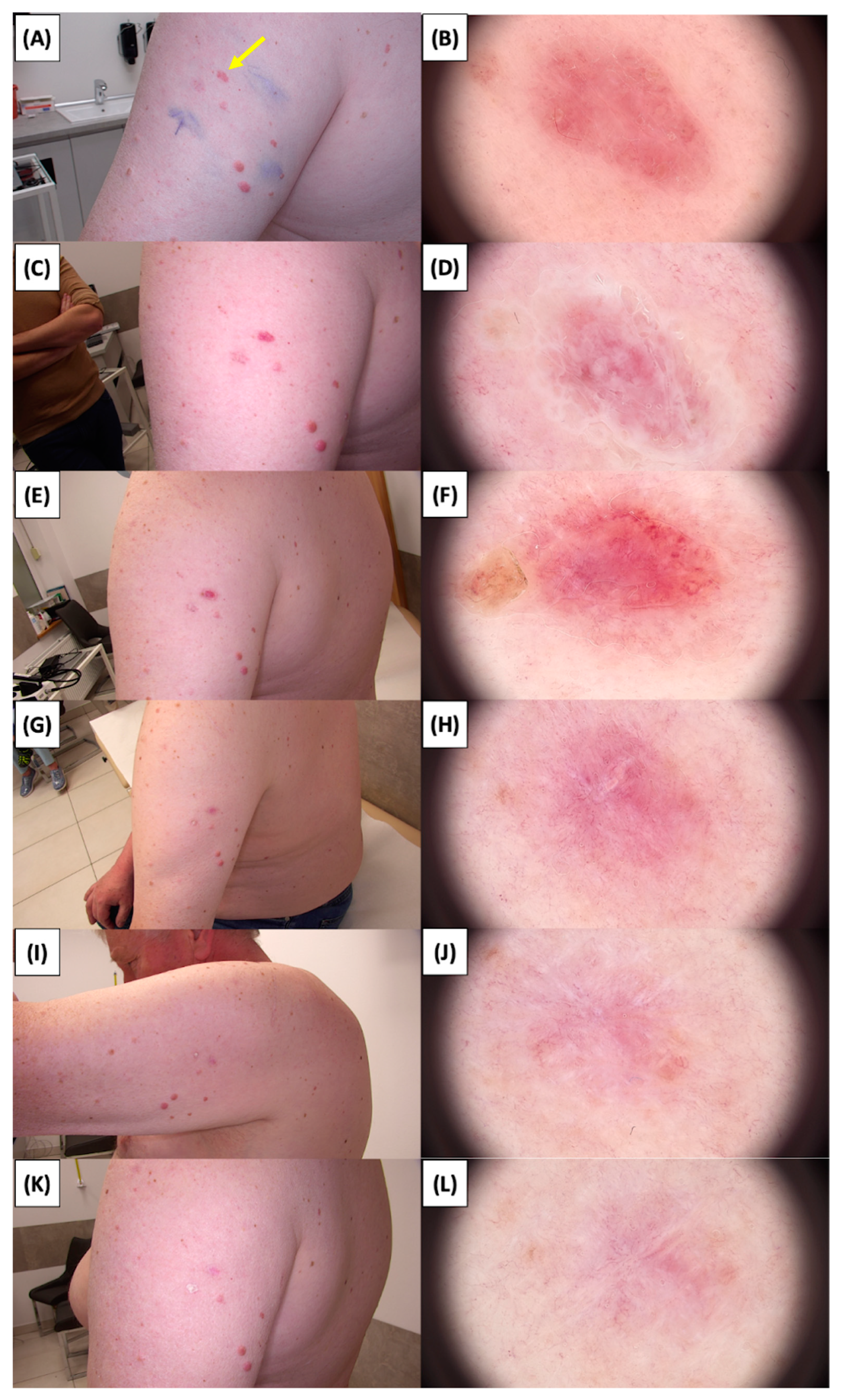

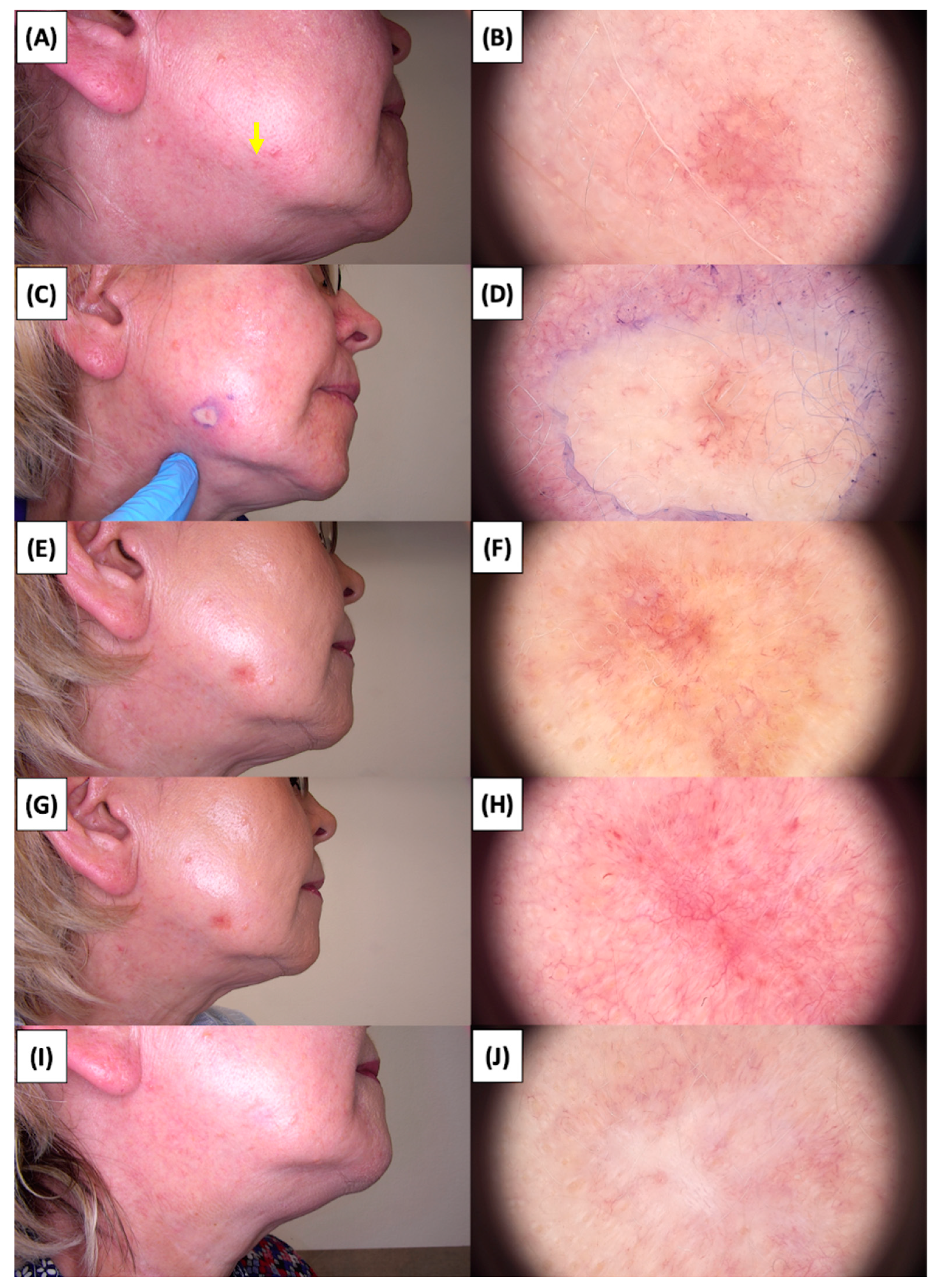

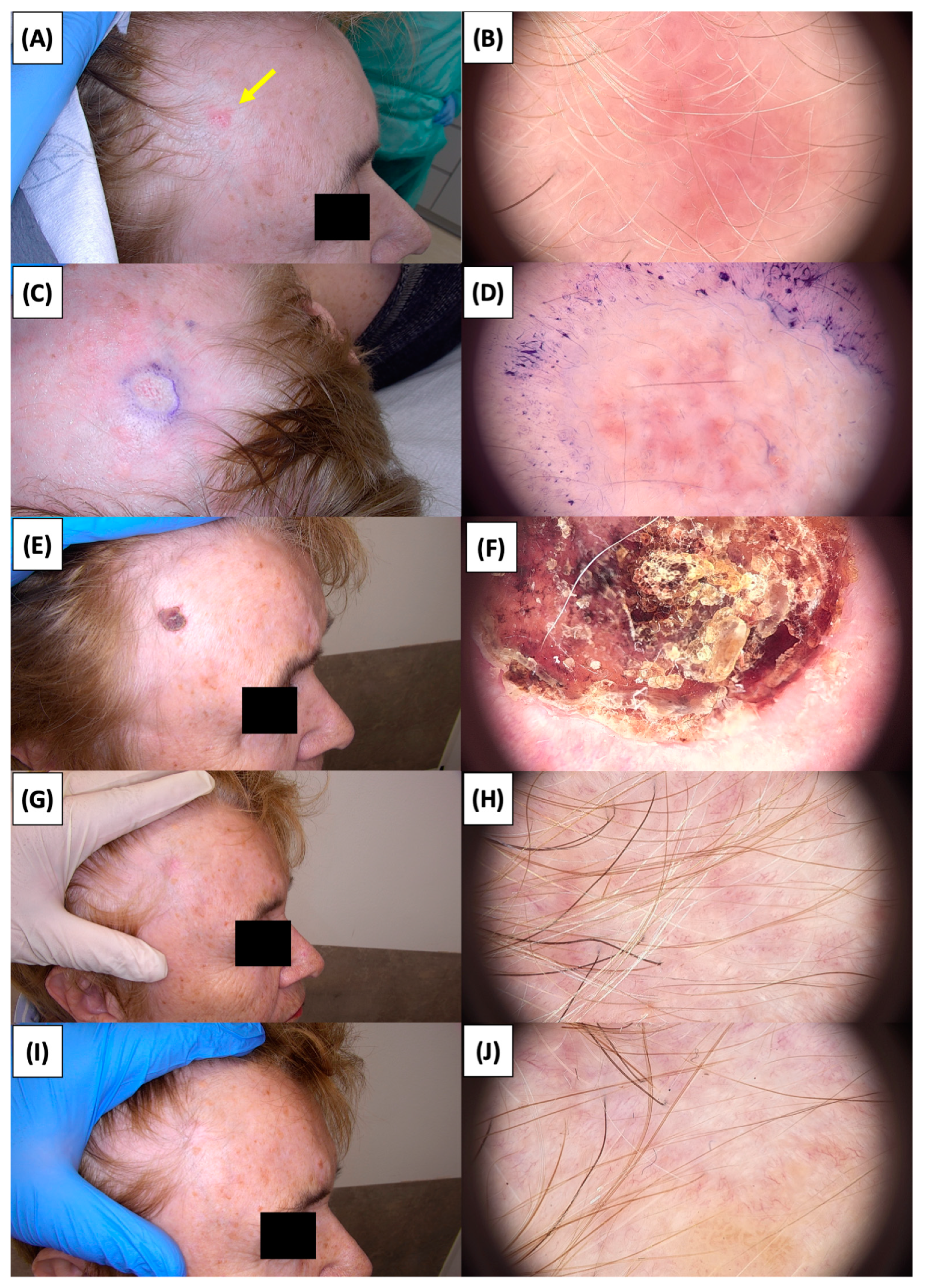

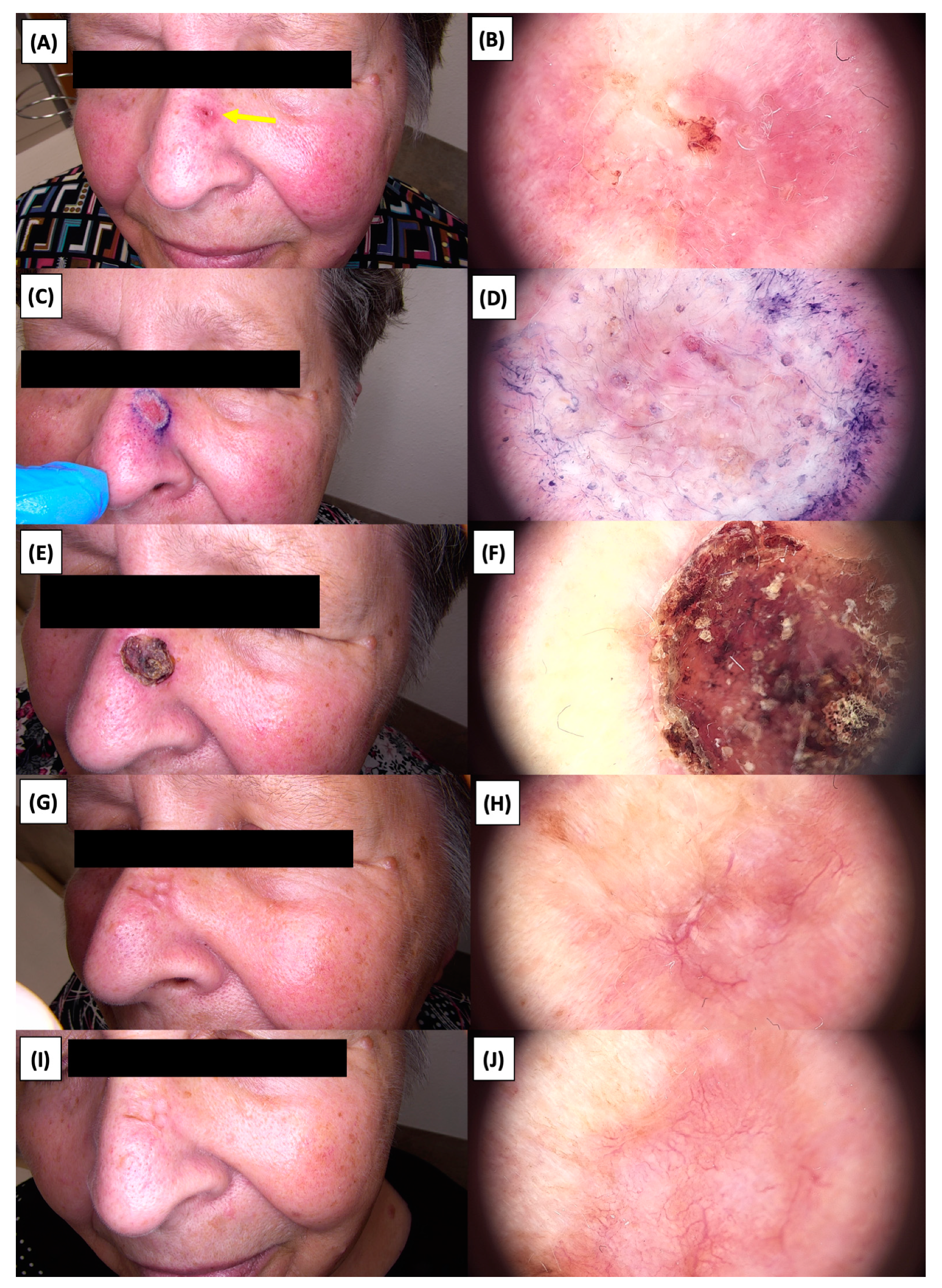



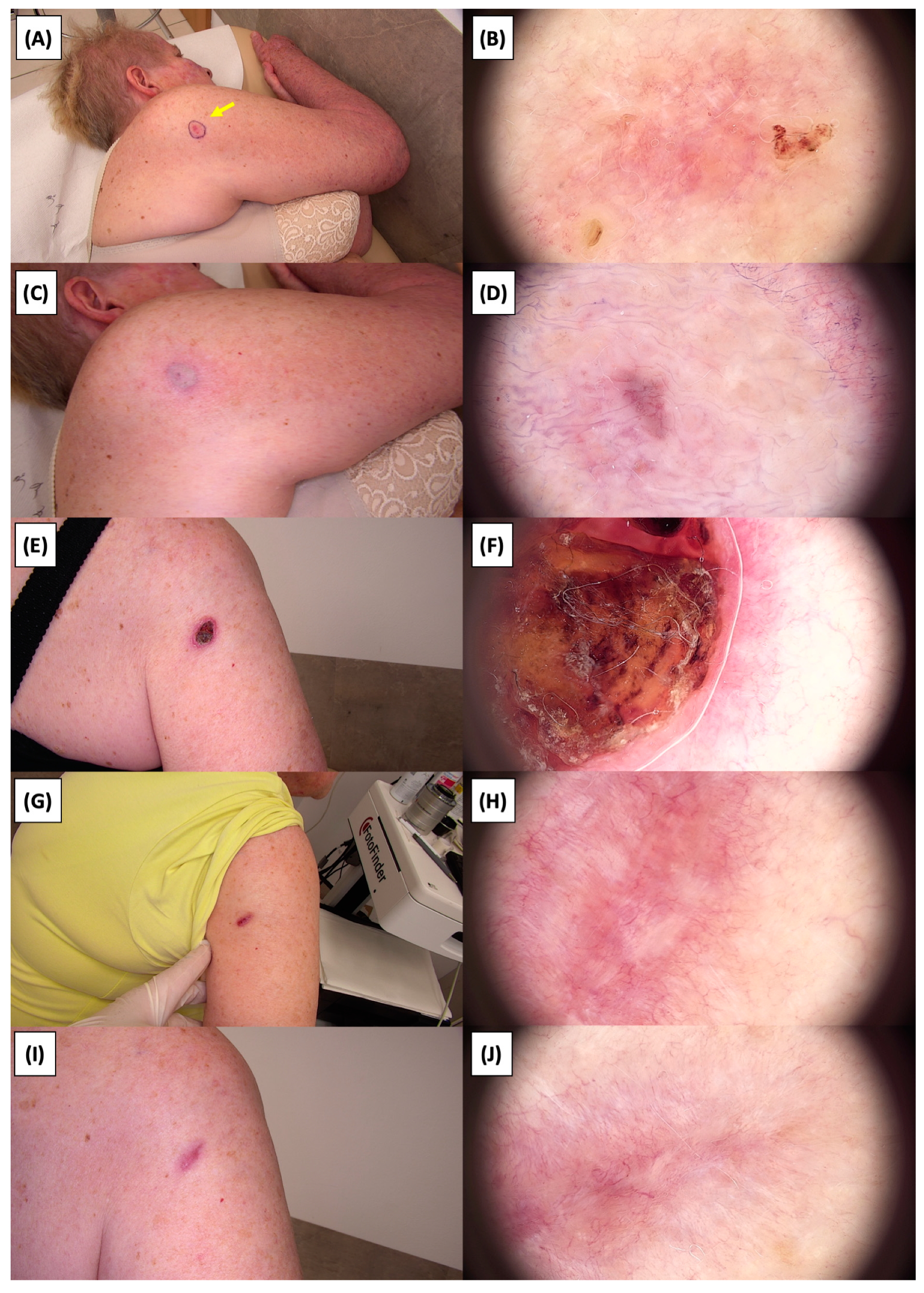











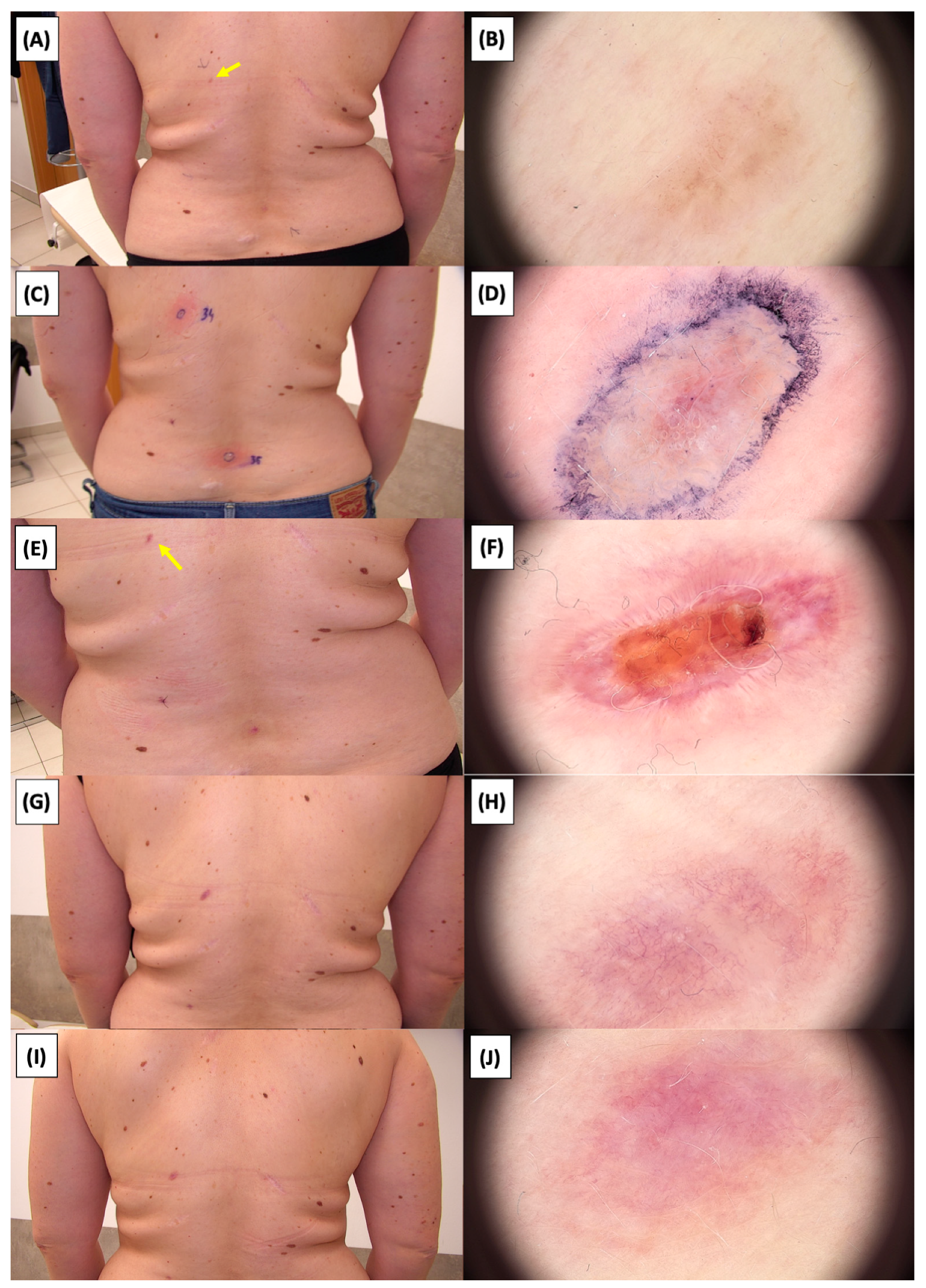


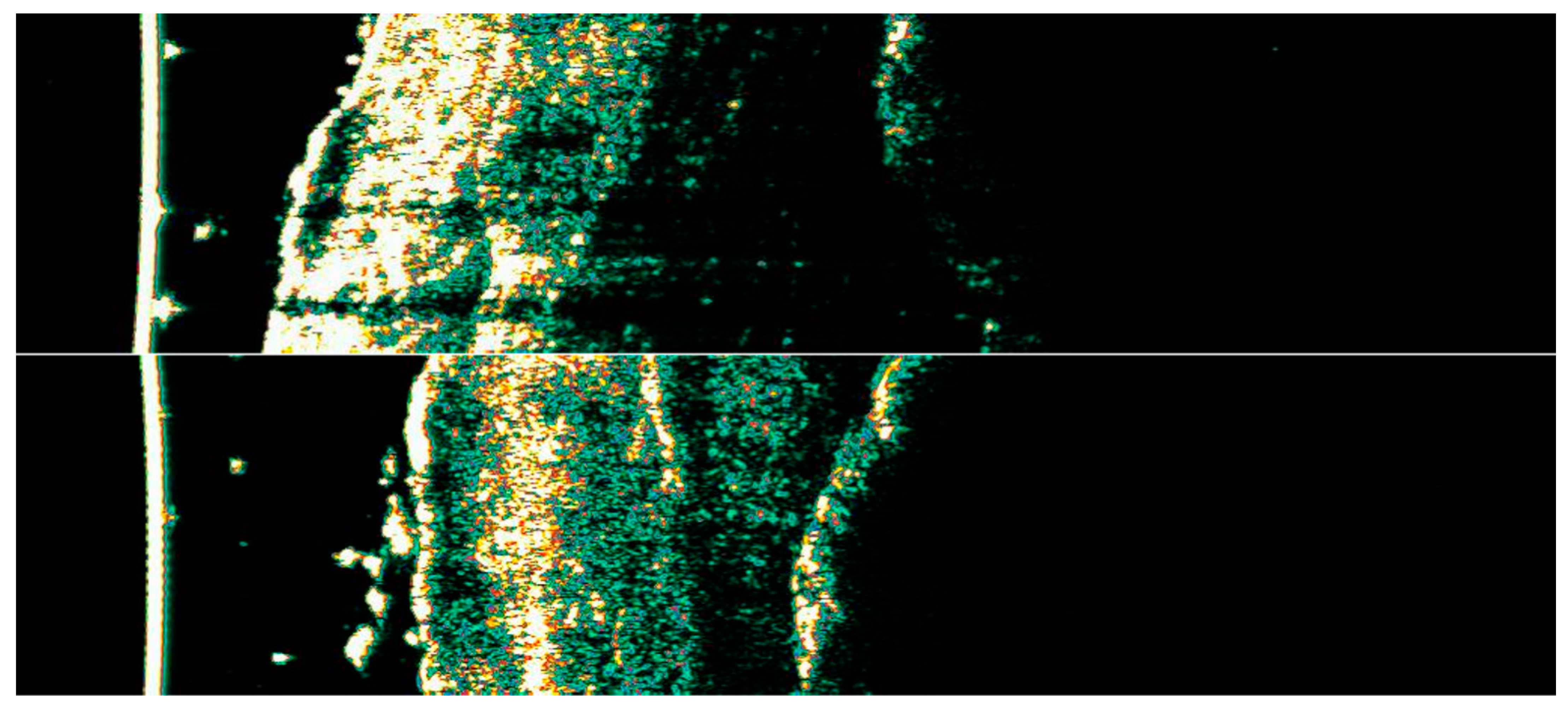
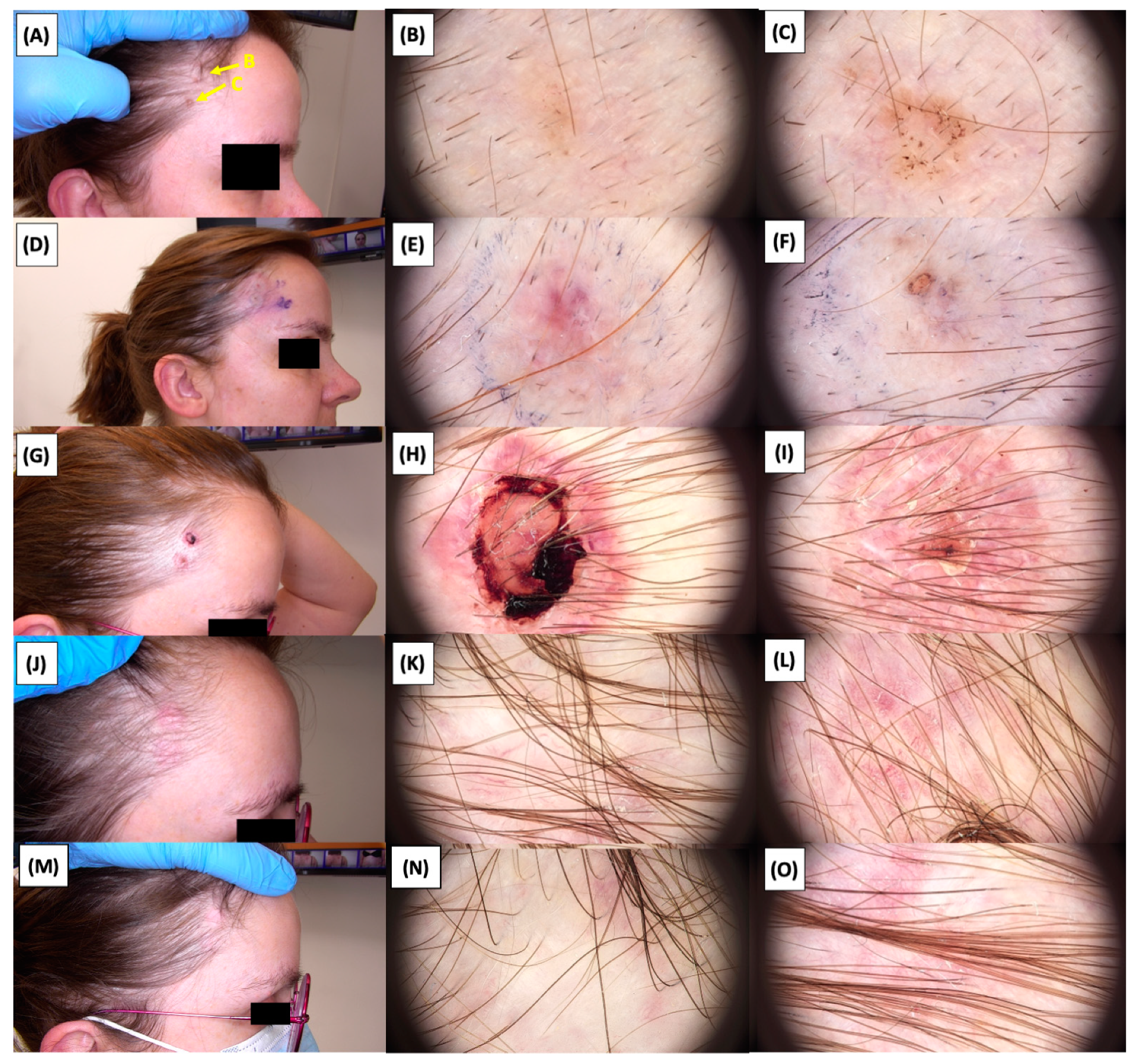
| BCC Number | HIFU Procedure | ||||
|---|---|---|---|---|---|
| Transducer Depth (mm) | Pulse Duration (ms) | Energy per Pulse (J/shot) | Number of Pulses | Treatment Time (min) | |
| 1. | 0.8 | 150 | 1.3 | 78 | 20 |
| 2. | 0.8 | 150 | 1.3 | 250 | 45 |
| 3. | 0.8 | 150 | 1.3 | 170 | 20 |
| 4. | 0.8 | 150 | 1.2 | 50 | 20 |
| 5. | 1.8 | 150 | 1.3 | 100 | 30 |
| 0.8 | 150 | 1.3 | 110 | ||
| 6. | 1.3 | 150 | 1.3 | 85 | 30 |
| 7. | 0.8 | 150 | 1.3 | 145 | 40 |
| 8. | 0.8 | 150 | 1.3 | 40 | 120 |
| 9. | 0.8 | 150 | 1.3 | 70 | |
| 10 | 0.8 | 150 | 1.3 | 113 | |
| 11 | 0.8 | 150 | 1.3 | 123 | |
| 12 | 0.8 | 150 | 1.3 | 87 | |
| 13 | 0.8 | 150 | 1.3 | 88 | |
| 14 | 0.8 | 150 | 1.3 | 91 | |
| 15 | 0.8 | 150 | 1.3 | 159 | |
| Number of Changes | Vascular Patterns | Pigment Structures | Non-Pigmented Structures | |||||||||||||
|---|---|---|---|---|---|---|---|---|---|---|---|---|---|---|---|---|
| Ambrozing Linear | Short Linear | Loop-like Linear | Bent Linear | Clod-like Linear | Segmentally Arranged | Radially Arranged Linear | Angular Linear | Small Gray-Blue Globules | Large Gray-Blue Globules | White Lines | Small White Structureless Areas | Pink Structureless Areas | White-Yellow Globules | Yellow Globule–Ulceration | Rosettes | |
| 1. | X | X | X | X | X | 3 | ||||||||||
| 2. | X | X | 1 | |||||||||||||
| 3. | X | X | X | |||||||||||||
| 4. | X | X | X | |||||||||||||
| 5. | X | X | X | X | 2 | X | ||||||||||
| 6. | X | X | X | 2 | X | |||||||||||
| 7. | X | X | X | X | 1 | X | ||||||||||
| 8. | X | X | 1 | X | ||||||||||||
| 9. | X | X | X | X | X | |||||||||||
| 10. | X | X | X | X | X | 1 | ||||||||||
| 11. | X | X | X | 2 | X | |||||||||||
| 12. | X | X | X | X | X | 2 | X | |||||||||
| 13. | X | X | X | 2 | X | X | ||||||||||
| 14. | X | X | X | 3 | ||||||||||||
| 15. | X | X | X | X | X | 2 | ||||||||||
| Number of Changes | Vascular Patterns | Pigment Structures | Non-Pigmented Structures | ||||||||||||||||
|---|---|---|---|---|---|---|---|---|---|---|---|---|---|---|---|---|---|---|---|
| Ambrozing Linear | Short Linear | Loop-like Linear | Bent Linear | Clod-like Linear | Radially Arranged | Segmentally Arranged | Reticular | Segmentally Arranged Linear | Radially Arranged Linear | Angular Linear | Small Gray-Blue Globules | Large Gray-Blue Globules | White Lines | Small White Structureless Areas | Pink Structureless Areas | White-Yellow Globules | Orange Globule–Crust | Rosettes | |
| 1. | X | 3 | X | ||||||||||||||||
| 2. | X | X | X | X | X | 2 | |||||||||||||
| 3. | X | X | X | ||||||||||||||||
| 4. | X | X | X | 2 | X | ||||||||||||||
| 5. | X | X | X | 3 | X | X | |||||||||||||
| 6. | X | X | X | X | X | 3 | X | ||||||||||||
| 7. | X | X | X | X | 3 | X | |||||||||||||
| 8. | X | X | X | X | 3 | ||||||||||||||
| 9. | X | X | X | 2 | |||||||||||||||
| 10. | X | X | X | 2 | X | ||||||||||||||
| 11. | X | X | 2 | X | |||||||||||||||
| 12. | X | X | 3 | X | |||||||||||||||
| 13. | X | X | X | X | X | ||||||||||||||
| 14. | X | 2 | X | ||||||||||||||||
| 15. | X | X | 3 | X | |||||||||||||||
| Number of Changes | Vascular Patterns | Pigment Structures | Non-Pigmented Structures | ||||||||||||||||
|---|---|---|---|---|---|---|---|---|---|---|---|---|---|---|---|---|---|---|---|
| Ambrozing Linear | Short Linear | Loop-like Linear | Bent Linear | Clod-like Linear | Radially Arranged | Segmentaly Arranged | Reticular | Segmentally Arranged Linear | Radially Arranged Linear | Angular Linear | Small Gray-Blue Globules | Large Gray-Blue Globules | White Lines | Small White Structureless Areas | Pink Structureless Areas | White-Yellow Globules | Orange Globule–Crust | Rosettes | |
| 1. | X | X | X | X | 2 | ||||||||||||||
| 2. | X | X | X | 2 | |||||||||||||||
| 3. | X | X | 1 | ||||||||||||||||
| 4. | X | 1 | |||||||||||||||||
| 5. | X | X | 2 | ||||||||||||||||
| 6. | X | X | 2 | ||||||||||||||||
| 7. | X | X | 1 | X | |||||||||||||||
| 8. | X | X | 2 | ||||||||||||||||
| 9. | X | X | 2 | X | |||||||||||||||
| 10. | X | X | 1 | X | |||||||||||||||
| 11. | X | X | X | X | 2 | ||||||||||||||
| 12. | X | 2 | |||||||||||||||||
| 13. | X | X | X | 2 | |||||||||||||||
| 14. | X | X | 2 | ||||||||||||||||
| 15. | X | X | X | X | X | 1 | |||||||||||||
| Number of Changes | Vascular Patterns | Pigment Structures | Non-Pigmented Structures | ||||||||||||||||
|---|---|---|---|---|---|---|---|---|---|---|---|---|---|---|---|---|---|---|---|
| Ambrozing Linear | Short Linear | Loop-like Linear | Bent Linear | Clod-like Linear | Radially Arranged | Segmentally Arranged | Reticular | Segmentally Arranged Linear | Radially Arranged Linear | Angular Linear | Small Gray-Blue Globules | Large Gray-Blue Globules | White Lines | Small White Structureless Areas | Pink Structureless Areas | White-Yellow Globules | Orange Globule–Crust | Rosettes | |
| 1. | X | X | X | X | 1 | ||||||||||||||
| 2. | X | X | X | 2 | |||||||||||||||
| 3. | X | 1 | |||||||||||||||||
| 4. | X | 2 | |||||||||||||||||
| 5. | X | 1 | |||||||||||||||||
| 6. | X | X | 2 | ||||||||||||||||
| 7. | X | 1 | X | ||||||||||||||||
| 8. | X | X | 2 | ||||||||||||||||
| 9. | X | X | 2 | ||||||||||||||||
| 10. | 1 | X | |||||||||||||||||
| 11. | X | X | 1 | ||||||||||||||||
| 12. | X | 1 | |||||||||||||||||
| 13. | X | X | 2 | ||||||||||||||||
| 14. | X | X | 1 | ||||||||||||||||
| 15. | X | X | 1 | ||||||||||||||||
| Number of Lesion | Adverse Events (2–10 min Post-HIFU Treatment): | ||||||||
|---|---|---|---|---|---|---|---|---|---|
| Transient Urticaria | Edema | Erythema | Hemorrhagic Purpura | Inflammation | Crust Formation | Hyperpigmentation | Hypopigmentation | Scarring | |
| 1. | X | X | |||||||
| 2. | X | X | X | ||||||
| 3. | X | ||||||||
| 4. | X | X | |||||||
| 5. | |||||||||
| 6. | X | X | X | ||||||
| 7. | X | ||||||||
| 8. | X | X | X | ||||||
| 9. | X | X | X | ||||||
| 10. | X | X | X | X | |||||
| 11. | X | X | X | ||||||
| 12. | X | X | X | X | |||||
| 13. | X | X | X | X | |||||
| 14. | X | X | X | ||||||
| 15. | X | X | X | ||||||
| Patient | Adverse Events (2 weeks post-HIFU treatment) | ||||||||
| 1. | X | X | |||||||
| 2. | X | X | |||||||
| 3. | X | X | X | ||||||
| 4. | X | ||||||||
| 5. | X | ||||||||
| 6. | X | ||||||||
| 7. | X | X | |||||||
| 8. | X | X | |||||||
| 9. | X | ||||||||
| 10. | |||||||||
| 11. | X | ||||||||
| 12. | |||||||||
| 13. | |||||||||
| 14. | |||||||||
| 15. | |||||||||
| Patient | Adverse Events (3 months post-HIFU treatment) | ||||||||
| 1. | X | X | |||||||
| 2. | |||||||||
| 3. | X | X | |||||||
| 4. | X | X | |||||||
| 5. | X | X | |||||||
| 6. | X | ||||||||
| 7. | X | X | |||||||
| 8. | X | X | |||||||
| 9. | |||||||||
| 10. | |||||||||
| 11. | |||||||||
| 12. | |||||||||
| 13. | |||||||||
| 14. | |||||||||
| 15. | |||||||||
| Patient | Adverse Events (6 months post-HIFU treatment) | ||||||||
| 1. | X | ||||||||
| 2. | |||||||||
| 3. | X | X | |||||||
| 4. | X | ||||||||
| 5. | X | ||||||||
| 6. | X | ||||||||
| 7. | X | X | X | ||||||
| 8. | X | X | X | ||||||
| 9. | |||||||||
| 10. | |||||||||
| 11. | |||||||||
| 12. | |||||||||
| 13. | |||||||||
| 14. | |||||||||
| 15. | |||||||||
| Assessment of Patient Sensations after HIFU Procedure | ||||||||
| Patient | Intensity of Adverse Effects (0–3) | Pain Level during Treatment (0–10) | Pain Level a Few Minutes after Treatment (0–10) | Itching (0–10) | Comparative Method | Comparative Method (0–4) | Other Adverse Effects | Intensity of Adverse Effects (Total) (0–3) |
| 1. | Mild (1) | 3 | 0 | 0 | Surgical excision | Other methods cause significantly more discomfort (4) | None | Mild (1) |
| 2. | Moderate (2) | 7 | 2 | 0 | Cryotherapy | Other methods cause slightly less discomfort (1) | None | Moderate (2) |
| 3. | Mild (1) | 1 | 0 | 0 | Surgical excision | Other methods cause significantly more discomfort (4) | significant pain upon palpation, post-procedural sensory disturbances that persist for an extended duration | Mild (1) |
| 4. | Mild (1) | 3 | 0 | 0 | Surgical excision | Other methods cause significantly more discomfort (4) | None | Mild (1) |
| 5. | Mild (1) | 3 | 0 | 0 | Cryotherapy | Other methods cause slightly less discomfort (1) | None | Moderate (2) |
| 6. | Mild (1) | 3 | 0 | 0 | Surgical excision | Other methods cause slightly less discomfort (1) | None | Mild (1) |
| 7. | Mild (1) | 3 | 1 | 0 | Surgical excision | Other methods cause slightly less discomfort (1) | Burning sensation | Mild (1) |
| 8. | Mild (1) | 1 | 0 | 0 | Cryotherapy | Other methods cause significantly more discomfort (4) | None | Mild (1) |
| Assessment of patient sensations 2 weeks after HIFU treatment | ||||||||
| Patient | Intensity of adverse effects (0–3) | Assessment of the healing process (0–3) | Degree of pain in treated areas (0–10) | Degree of itching (0–10) | Comparative method | Comparative method (0–4) | Other adverse effects | Intensity of adverse effects (total) |
| 1. | Mild (1) | Satisfied (3) | 1 | 0 | Surgical excision | Other methods cause the same discomfort (2) | None | Mild (1) |
| 2. | Mild (1) | Neutral (2) | 3 | 0 | Cryotherapy | Other methods cause slightly less discomfort (1) | None | Mild (1) |
| 3. | Mild (1) | Very satisfied (4) | 0 | 0 | Surgical excision | Other methods cause significantly more discomfort (4) | None | Mild (1) |
| 4. | Mild (1) | Very satisfied (4) | 0 | 2 | Surgical excision | Other methods cause significantly more discomfort (4) | None | Mild (1) |
| 5. | Mild (1) | Satisfied (3) | 1 | 1 | Cryotherapy | Other methods cause slightly less discomfort (1) | None | Mild (1) |
| 6. | Mild (1) | Satisfied (3) | 0 | 1 | Surgical excision | Other methods cause the same discomfort (2) | None | Mild (1) |
| 7. | Mild (1) | Satisfied (3) | 0 | 0 | Surgical excision | Other methods cause slightly less discomfort (1) | None | Mild (1) |
| 8. | Mild (1) | Very satisfied (4) | 0 | 0 | Cryotherapy | Other methods cause significantly more discomfort (4) | None | Mild (1) |
| Assessment of patient sensations 3 months after HIFU treatment | ||||||||
| 1. | Mild (1) | Neutral (2) | 0 | 1 | Surgical excision | Other methods cause greater discomfort (3) | None | Mild (1) |
| 2. | None (0) | Satisfied (3) | 0 | 0 | Cryotherapy | Other methods cause greater discomfort (3) | paresthesia and punctate pain at the treatment site | Moderate (2) |
| 3. | Mild (1) | Satisfied (3) | 0 | 1 | Surgical excision | Other methods cause greater discomfort (3) | None | Mild (1) |
| 4. | Mild (1) | Satisfied (3) | 0 | 0 | Surgical excision | Other methods cause significantly more discomfort (4) | None | Mild (1) |
| 5. | Mild (1) | Neutral (2) | 0 | 1 | Cryotherapy | Other methods cause greater discomfort (3) | None | Moderate (2) |
| 6. | Mild (1) | Satisfied (3) | 0 | 0 | Surgical excision | Other methods cause greater discomfort (3) | None | Mild (1) |
| 7. | Mild (1) | Neutral (2) | 0 | 0 | Surgical excision | Other methods cause significantly more discomfort (4) | Fibrosis within the lesion | Mild (1) |
| 8. | Mild (1) | Very satisfied (4) | 0 | 0 | Cryotherapy | Other methods cause significantly more discomfort (4) | None | None (0) |
| Assessment of patient sensations 6 months after HIFU treatment | ||||||||
| 1. | Mild (1) | Satisfied (3) | 0 | 0 | Surgical excision | Other methods cause significantly more discomfort (4) | None | Moderate (2) |
| 2. | Mild (1) | Very satisfied (4) | 0 | 0 | Cryotherapy | Other methods cause the same discomfort (2) | None | Mild (1) |
| 3. | Mild (1) | Very satisfied (4) | 0 | 0 | Surgical excision | Other methods cause greater discomfort (3) | None | Mild (1) |
| 4. | Mild (1) | Very satisfied (4) | 0 | 0 | Surgical excision | Other methods cause significantly more discomfort (4) | None | Mild (1) |
| 5. | Mild (1) | Satisfied (3) | 0 | 0 | Cryotherapy | Other methods cause the same discomfort (2) | None | Mild (1) |
| 6. | Mild (1) | Very satisfied (4) | 0 | 0 | Surgical excision | Other methods cause greater discomfort (3) | None | None (0) |
| 7. | Mild (1) | Very satisfied (4) | 0 | 0 | Surgical excision | Other methods cause significantly more discomfort (4) | None | Mild (1) |
| 8. | Mild (1) | Very satisfied (4) | 0 | 0 | Cryotherapy | Other methods cause significantly more discomfort (4) | None | Mild (1) |
Disclaimer/Publisher’s Note: The statements, opinions and data contained in all publications are solely those of the individual author(s) and contributor(s) and not of MDPI and/or the editor(s). MDPI and/or the editor(s) disclaim responsibility for any injury to people or property resulting from any ideas, methods, instructions or products referred to in the content. |
© 2024 by the authors. Licensee MDPI, Basel, Switzerland. This article is an open access article distributed under the terms and conditions of the Creative Commons Attribution (CC BY) license (https://creativecommons.org/licenses/by/4.0/).
Share and Cite
Calik, J.; Sauer, N.; Woźniak, B.; Wojnar, A.; Pietkiewicz, P.; Dzięgiel, P. Pilot Study on High-Intensity Focused Ultrasound (HIFU) for Basal Cell Carcinoma: Effectiveness and Safety. J. Clin. Med. 2024, 13, 3277. https://doi.org/10.3390/jcm13113277
Calik J, Sauer N, Woźniak B, Wojnar A, Pietkiewicz P, Dzięgiel P. Pilot Study on High-Intensity Focused Ultrasound (HIFU) for Basal Cell Carcinoma: Effectiveness and Safety. Journal of Clinical Medicine. 2024; 13(11):3277. https://doi.org/10.3390/jcm13113277
Chicago/Turabian StyleCalik, Jacek, Natalia Sauer, Bartosz Woźniak, Andrzej Wojnar, Paweł Pietkiewicz, and Piotr Dzięgiel. 2024. "Pilot Study on High-Intensity Focused Ultrasound (HIFU) for Basal Cell Carcinoma: Effectiveness and Safety" Journal of Clinical Medicine 13, no. 11: 3277. https://doi.org/10.3390/jcm13113277
APA StyleCalik, J., Sauer, N., Woźniak, B., Wojnar, A., Pietkiewicz, P., & Dzięgiel, P. (2024). Pilot Study on High-Intensity Focused Ultrasound (HIFU) for Basal Cell Carcinoma: Effectiveness and Safety. Journal of Clinical Medicine, 13(11), 3277. https://doi.org/10.3390/jcm13113277






